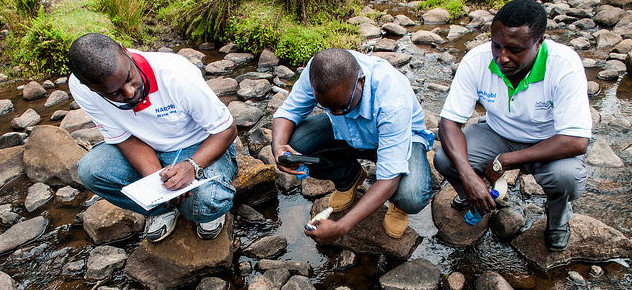
The Tana-Nairobi Water Fund will protect a watershed that provides water for more than 9.3 million people and is responsible for 60% of the country’s energy production. Credit: Georgina Smith / CIAT
Every rainy season Jane Kabugi’s home comes under attack. The torrential rain so desperately needed downstream to meet Kenya’s rising demand for hydropower – and Nairobi’s water requirements – has literally been tearing her home and farm apart.
“There was a time when this house of mine was almost gone; it was starting to crack. An engineer came and said ‘if you want to save your house, you need to make a strong hold, so the soil can be held’,” she said.
Like 90% of the one million farmers in Kenya’s Tana region, northwest of Nairobi, Jane grows crops on a steep hillside. She explains:
“Our soil is very soft. So when it rains, the rain tends to take the soil away. If I put manure, it takes it; if I put fertilizer, it takes it.” Far from just affecting farmers’ homes and livelihoods, the knock-on effect downstream is threatening water and energy supplies.
@fredkizito @CIAT_ talking live on @cnbcafrica taking about #NairobiWaterFund @Nature_Africa pic.twitter.com/hNNXNkTm8j
— Stephanie Malyon (@StephanieMalyon) March 20, 2015
In March 2015, CIAT joined The Nature Conservancy and other partners to launch the Tana-Nairobi Water Fund – the first of its kind in Africa. The Fund will safeguard one of Kenya’s most productive agricultural areas and also protect a watershed that provides 60% of the country’s energy production and water for more than 9.3 million people.
The Tana-Nairobi Water Fund is a public-private scheme uniting big business, utilities, conservation groups, government, researchers, and farmers. It aims to increase farm productivity upstream, while improving water supplies and cutting the costs of hydropower and clean water for users downstream. The Fund is designed to generate US$21.5 million in long-term benefits for Kenyan citizens, including farmers and businesses.
If successful, the fund could pave the way for “payment for ecosystem services” projects across the continent. Downstream users, such as Coca-Cola, East African Breweries, and utility companies, will pay upstream “guardians” to implement strategic measures, such as tree planting, terracing, and drip irrigation, to protect the upper watershed.
Africa’s 1st Water Fund will bring $21.5m in benefits for Kenyans http://t.co/m1YBze9mIC #NairobiWaterFund #LoveWater pic.twitter.com/EojvEVupIE
— TNC Africa (@Nature_Africa) March 20, 2015
Research has played a major role in developing the Tana-Nairobi Water Fund and is vital for ensuring the Fund delivers the benefits it promises. With support from the CGIAR Research Program on Water, Land and Ecosystems (WLE), CIAT used its expertise in detecting and mapping land-use change to inform targeted investments aimed at preventing major ecosystem damage.

Soil erosion washes away valuable top soil, which affects communities downstream. Credit: Georgina Smith / CIAT
By projecting scenarios of land-use changes, partners working on the ground can advise farmers on smart cropping interventions and possible alternatives for diversification. For example, if rangelands – which currently cover 25% of the Tana River’s priority watersheds – become more suitable for agriculture, then it will be crucial to advise farmers on management practices needed to avoid soil run-off and increased sedimentation.
“Detecting and predicting the causes of sedimentation is only part of the work,” said Fred Kizito, CIAT soil scientist. “We can only know if the Water Fund is delivering on its promises by monitoring the impact of interventions targeted for different areas within the watershed.”
Working in partnership with Kenya’s Water and Resource Management Authority, CIAT will measure real-time water quality at specific points along the watershed. Center scientists will also inform decisions about land management options by measuring the effectiveness of different interventions – such as terracing and grass strips – so they can be tailored to specific areas of the watershed.
Intervention measures are already helping Jane protect her home and livelihood. In January 2014, she met the Sustainable Agriculture Community Development Programme (SACDEP), a Water Fund partner. As part of a pilot scheme enabling 5,000 farmers in the upper catchment to adopt conservation measures, SACDEP taught Jane how to protect her soil by digging trenches, and planting trees, bamboo, and Napier grass.
“Every trench I make at least 4 feet deep. But you see this one is less than 6 inches. It’s been covered by water and soil from the top of my farm. If the trenches were not there – my soil would have washed down and spoiled the water in the river, taking all the fertilizer and manure I’ve struggled to put down,” Jane explained.
Jane, a retired employee of the Ministry of Agriculture, is now an upstream “guardian.” She shares what she has learned with other farmers in her area, so they can protect their farms and prevent soil, manure, and fertilizer from being washed away, polluting the river for downstream users. With the launch of the fund, partners will now target thousands of farmers across the watershed to provide them with training and support to implement soil-saving techniques.
To know more about soil erosion in the Tana River Basin: